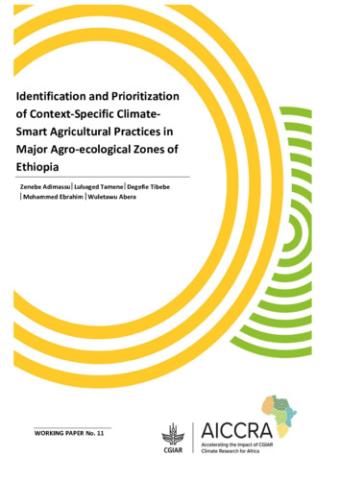Abstract
Ethiopian agriculture generates about 36% of GDP and 66% of employment. It is deeply affected by climate change, uncertainty, and extremes, all of which significantly reduce GDP. Climate-smart agriculture (CSA) can reduce the risks and impacts of climate change. The CSA concept calls for meeting three key objectives or pillars: i) sustainably increasing food security through productivity increases (productivity, P); ii) building resilience and adapting to climate change (adaptation, A), and iii) reducing greenhouse gas emissions (mitigation, M)
There are many site-specific CSA options available across various agro-ecological zones in Ethiopia. Identifying best-bet CSA options is crucial for planning and implementing CSA for spatial targeting areas and scales including agro-ecological zones. Planning and implementing CSA at plot, farm, or landscape level must be considered in relation to the three CSA pillars (P, A and M). Farmer adoption of such practices is affected by their economic feasibility.
The study objectives were therefore to i) identify and prioritize CSA practices across major agro-ecologies of Ethiopia in relation to the three CSA pillars, and gender-equity parameters, and ii) assess the costs and benefits of selected CSA practices. To achieve this, the study identified, analyzed, and ranked CSA practices in the five production-system areas of: i) Crop production and management (CPM); ii) Erosion control and water management (ECWM); iii) Forestry and agroforestry (FAF); iv) Integrated soil fertility management (ISFM); and v) Livestock production and management (LPM).
The study applied the CCAFS-CSA Prioritization framework for identifying and prioritizing CSA practices. A participatory approach i) compiled a long list of CSA practices, characterizing them based on productivity, adaptation, mitigation, gender equity, and social-inclusion indicators), ii) identified best bet CSA practices, and iii) conducted a cost-benefit analysis of the selected CSA practices. Each step was informed by literature review and experts’ knowledge. A workshop identified and prioritized CSA practices in nine Ethiopian agro-ecological zones (AEZs)
The cost-benefit analysis assessed the economic feasibility of each identified CSA practice for each of AEZ. The results show that CSA practices related to agroforestry/forestry management practices, rangeland/forage improvement, and exclosure and water management addressed the goals associated with the three pillars (productivity, adaptation, mitigation) simultaneously. Also, most of the CSA practices addressed productivity and adaptation goals of CSA practices. This is mainly due to tradeoffs among the three pillars. Hence, these CSA practices should be integrated with other CSA practices to increase complementarity and achieve the pillars simultaneously. Prioritizing CSA practices based on AEZ provides opportunities to develop context-specific CSA packages across different AEZs and farms, and farmer types. Based on the types of farms/farmers, it is possible to develop CSA packages across the various agro-ecologies by considering the selected CSA practices in the five categories. Since this prioritization is based on experts’ knowledge at national level, it is also crucial to test and validate the CSA practices with various types of farmers in selected agro-ecologies. The economic feasibility (cost-benefit analysis) of CSA practices based on experts’ estimation and a literature review showed selected prioritized CSA practices are economically viable. However, due to limited information on the costs and benefits of CSA practices, CBA was conducted for only a limited number of CSA practices. This implies that detailed and exhaustive CSA practices should be conducted for the various CSA practices. The authors therefore recommend field validation in any future study.

